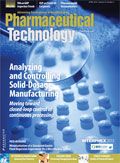The Affect of FDASIA on Inspections
David Elder, vice-president, technical at PAREXEL, discusses US legislation allows for inspection of generic-drug activities.

David ElderQ. How will the new FDASIA user fees affectinspections?
A. On July 9, 2012, President Obama signed into law the Food and Drug Administration Safety and Innovation Act (FDASIA). This legislation passed both the House and Senate with overwhelming bipartisan majorities, signifying an effective, cooperative legislation process that included FDA, Congress, patients, doctors, and the pharmaceutical and medical device industries.
The legislation is intended to provide FDA with added resources and authorities required to bring drugs and devices to market safely and quickly and promote innovation in the biomedical industry. In addition to the reauthorization of the Prescription Drug User Fee Act (PDUFA V) and the Medical Device User Fee and Modernization Act (MDUFMA III), it authorizes user fees for generic drugs and biosimilars. The Act establishes new initiatives, requirements, and authorities in other key areas as well and is certainly worth a careful study by its stakeholders.
The legislation includes explicit provisions relating to inspections but, in addition, it is important to understand the commitments made by FDA during the legislation negotiation time that will also drive implementation. When viewed collectively, I believe that the greatest impact of the new legislation to inspections will be in the area of generic drugs.
The Generic Drug User Fee Act (GDUFA), Title III of FDASIA, authorizes the agency to collect user fees to supplement the agency’s cost for conducting human generic-drug activities. Unlike the legacy user fee acts, GDUFA specifically defines covered FDA activities to include facility inspections. FDA has committed to conducting risk-adjusted biennial CGMP surveillance inspections of generic API and generic finished dosage form (FDF) manufacturers, with the goal of achieving parity of inspection frequency between foreign and domestic firms in FY 2017. One of the specific provisions in GDUFA is the requirement for sites to self-identify, which will provide FDA with a more complete and up-to-date inventory of generic drug establishments.
With a better inventory of generic drug establishments, the ability to allocate user fees to conduct inspections, a mandate to achieve inspection frequency parity among domestic and foreign establishments, a mandate for FDA to annually report year-to-year inspection metrics, and newly defined risk factors that include time since the last inspection, compliance history, and inherent product risk (see FDASIA Section 705), FDA is poised to significantly escalate the number of generic drug inspections worldwide.
This legislation also provides FDA with additional authorities that facilitate and augment its inspection program:
- Under FDASIA Section 706, drug establishments must provide FDA, upon request, any records FDA would be entitled to obtain during an on-site inspection
- Under FDASIA Section 707, drugs will be deemed misbranded if a drugestablishment delays, denies, or limits an inspection, or refuses to permit entry or inspection
- Under FDASIA Section 712, FDA may rely upon the inspections of capable foreign government agencies and may protect information received from foreign government agencies from disclosure under the Freedom of Information Act (FDASIA Section 708)
- Under FDASIA Section 718, there is now extraterritorial jurisdiction over any violation of the law if the drug or other regulated article was intended for import into the United States or if any act in furtherance of the violation was committed in the US.

Drug Shortages and Complying with FDA’s 21 CFR 211.110 Guidance
April 2nd 2025Susan J. Schniepp, distinguished fellow at Regulatory Compliance Associates, and Rona LeBlanc-Rivera, PhD, principal consultant, Regulatory Affairs at Regulatory Compliance Associates, answer some questions about FDA’s January 2025 21 CFR 211.110 guidance document.